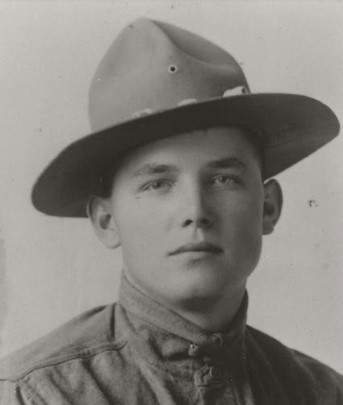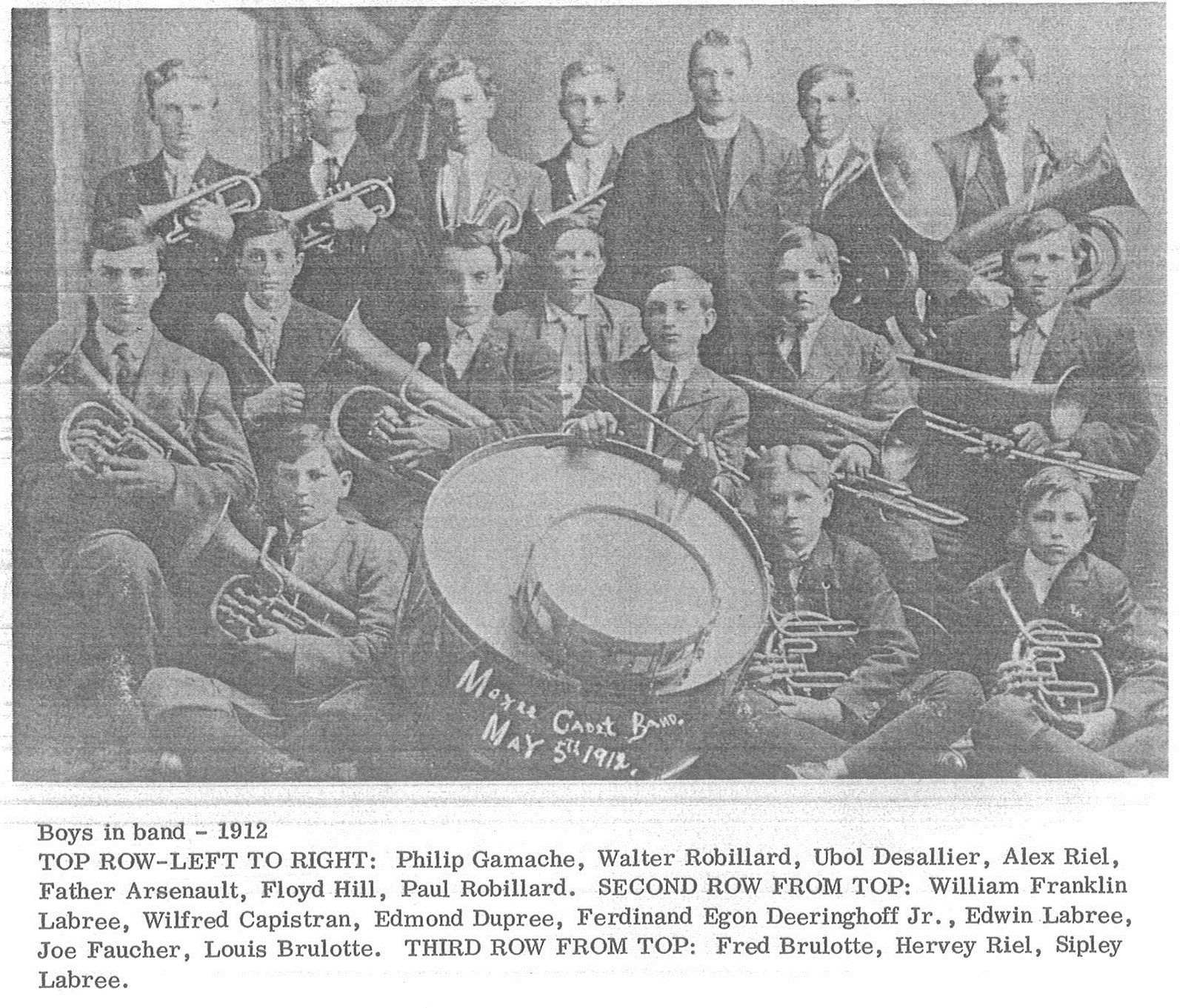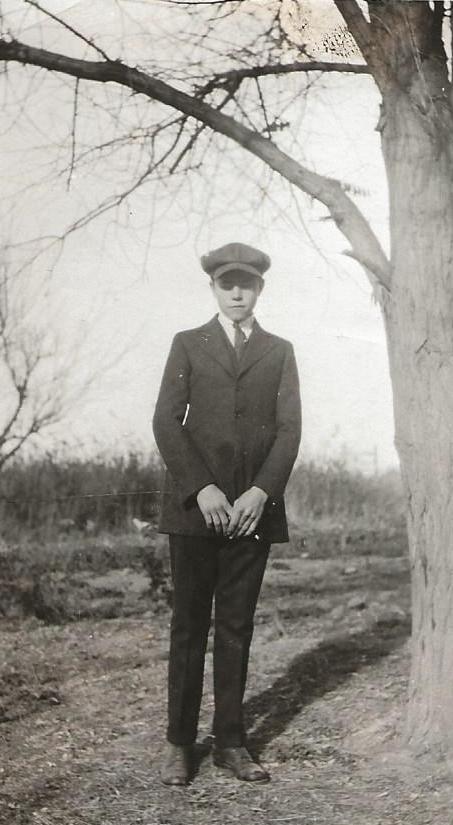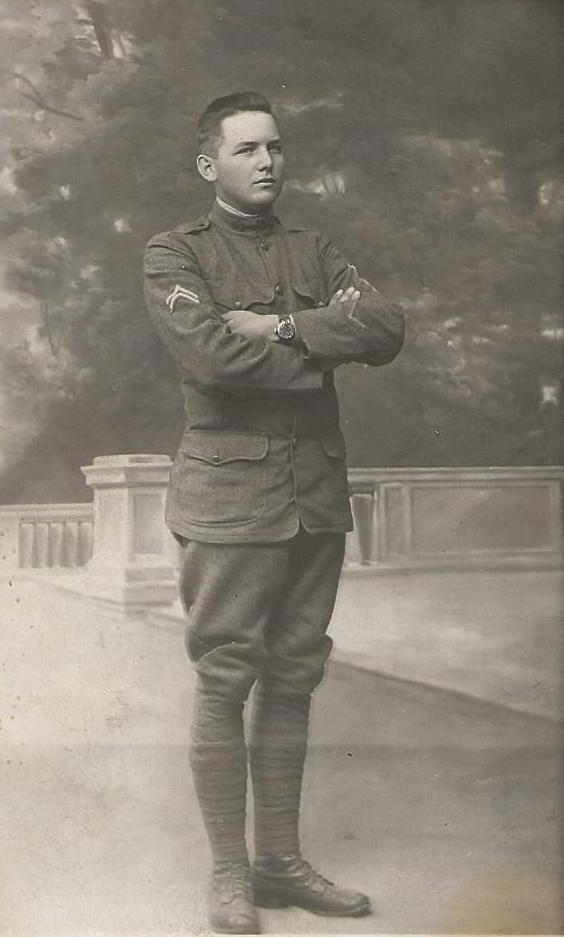Corporal Ferdinand Egon Deeringhoff

- Unit: 32nd Division, 127th Infantry Regiment, Company A
- Date of Birth: August 12, 1897
- Entered the Military: November 30, 1916
- Date of Death: October 15, 1918
- Hometown: Moxee City, Washington
- Place of Death: Meuse-Argonne Campaign, near Dame Marie, France
- Cemetery: Plot B, Row 33, Grave 31. Meuse-Argonne American Cemetery, Romagne-sous-Montfaucon, France
West Valley Junior High School
2018-2019
Early Life
On August 12, 1897, Ferdinand Egon Deeringhoff, Jr., known as Egon, was born in Yakima, Washington to Verena and Ferdinand Deeringhoff. Egon’s father immigrated from Germany to the United States in 1889 and settled in Uniontown, Washington. He worked as an agronomist (soil scientist) for the Northern Pacific Railroad. He soon moved and established a ranch in Moxee, a town just outside of Yakima, Washington.
Egon was the eldest son of seven children. He had four sisters, Mary, Gertrude, Clara, and Barbara, and two brothers, Norbert (Nibs) and Everett. The family was active in their local church, the Holy Rosary Parish where the Deeringhoff children attended school. Egon played the trumpet in the school’s band in 1912. The children spoke both English and German fluently in the household. Egon was a fair student and was the first to own and operate Moxee Valley’s first school bus, at the time, called a “kid hack.” The vehicle was a horse-drawn wagon that functioned the same as the motorized buses of today. After finishing school, Egon worked on the family farm.
The Deeringhoffs were a typical farming family in the late nineteenth century. Verena made all the family’s clothing. The ranch produced nearly everything the family needed, and Sears and Roebuck’s mail order service brought anything else that could not be made on the farm. The Deeringhoff children helped their parents around the ranch. The family made a trip to Yakima twice a year to buy everyone new shoes. The ranch served as a local gathering place and was always open to family and friends.
The Deeringhoff family remains an important part of agricultural history in the Yakima Valley. The first hops in Moxee were grown on the Deeringhoff ranch. Deeringhoff was instrumental in creating the Roza Irrigation District that brought irrigation water to the Yakima Valley. Although he did not live to see all the benefits of his work, it had a lasting impact on the community. Today Washington State is the nation’s largest producer of hops. One of the major roads in Moxee still bears the family name.



Military Experience
Egon Deeringhoff, Jr. joined the Washington National Guard in 1917. On March 25 the National Guard assigned Deeringhoff to the 2nd Washington Infantry. Following the declaration of war in April 1917, the War Department reorganized National Guard units from Washington, Oregon, Idaho, North Dakota, and Montana in July to form the 41st Infantry Division. The Division was assigned to Camp Greene, North Carolina. The U.S. Army combined the Washington 2nd and 3rd Infantry into the 161st Infantry Regiment, 81st Brigade, stationed at Fort Lewis in Washington.
After being transferred to Camp Mills, New York, the 161st Infantry Regiment departed Hoboken, New Jersey for France on December 13, 1917. When the 41st Division disembarked in France, it was named the Replacement Division, I Corps. The Army moved the Division to the Saint-Aignan-des-Noyers area in January 1918 and sent replacements to other American combat units. During one of these replacements, Deeringhoff was attached to the 32nd Division, 127th Infantry Regiment, Company A (64th Brigade).
Deeringhoff participated in the Meuse Argonne Offensive, which began on September 26, 1918. The 127th Infantry Regiment suffered heavy losses during the advance and was rotated off the front and relieved by the 128th Infantry Regiment.
By the morning on October 5, the 127th Infantry Regiment launched an attack. It took three days for the infantry to successfully advance the line. The Americans pushed the front line roughly two kilometers north of the town of Gesnes, France. The artillery barrages began on October 9. The 32nd Division fought to break the Kriemhilde Stellung, the main German line (also known as the Hindenburg Line). Despite the advances of the 126th and 128th Infantry Regiments, the 127th Infantry Regiment stalled in the hills near La Cote Dame Marie.
On October 14, the 126th and 127th Infantry Regiments bombarded the German flank that led to the surrender of over 500 Germans soldiers. The 127th Infantry Regiment led a bold nighttime march on the Dame Marie, France where they found abandoned German machine gun nests. By the morning of October 15, the 127th Infantry Regiment extended their line past Dame Marie and helped to shatter the Kriemhilde Stellung.
Corporal Deeringhoff died the next day, October 15, 1918. In his official report, Army Second Lieutenant Joseph Seidl wrote, “While Company was being held up by enemy machine gun fire, Cpl. Deeringhoff was hit by enemy shell while taking drink from the canteen, killing him instantly. This was on the 15 Oct. 1918. near Gesnes France. Place where buried or by whom unknown.”
Just three days after his death the American troops ultimately broke through the main German line.



Eulogy
Deeringhoff was initially buried in an isolated battlefield grave. On June 7, 1919, his remains were moved to the temporary American Romage-Meuse Cemetery. On July 6, 1923, the U.S. Army sent Verena Deeringhoff a letter notifying her that her son had been formally interred at the Meuse-Argonne American Cemetery in France. The Meuse-Argonne Cemetery contains the largest number of American war dead overseas – over 14,000 graves.
In 1929 the government passed a law to allow mothers of servicemembers who were buried overseas to visit their children’s graves. The government contacted Verena Deeringhoff in 1929 about making the trip, but Verena’s health did not permit her to visit her son’s grave in France. She passed away in 1942.
In addition to his headstone in France, Deeringhoff has been memorialized at the Holy Rosary Cemetery in Moxxee, Washington, along with other service members from the parish who were killed during World War I.

Reflection
Bibliography
32nd Division; Records of Combat Divisions, 1917-1919, Records of the American Expeditionary Forces (World War I), Record Group 120 (Boxes 23-24); National Archives at College Park, College Park, MD.
American Battle Monuments Commission. American Armies and Battlefields in Europe. Washington D.C.: Center of Military History, 2018. history.army.mil/html/books/023/23-24/CMH_Pub_23-24.pdf.
Chiello, Andrew M. The Laufer Family. Janesville: Wisconsin Heritage Fund, 1997.
Deeringhoff Family Photographs. 1916-1918. Courtesy of Barbara Hagedorn.
Denfeld, Duane. “161st Infantry Regiment, Washington National Guard.” HistoryLink.org. Updated February 1, 2012. Accessed March 1, 2019. www.historylink.org/File/10021.
Egon Deeringhoff. Photograph. Yakima Memory, Yakima Valley Museum (2004-114-255). Image. www.yakimamemory.org/cdm4/item_viewer.php?CISOROOT=/memory&CISOPTR=9906&CISOBOX=1&REC=13.
Ferdinand Egon. Photograph. Yakima Memory, Yakima Valley Museum (2004-114-259). Image.www.yakimamemory.org/cdm4/item_viewer.php?CISOROOT=/memory&CISOPTR=9910&CISOBX=1&REC=15.
“The Roll of Honor.” The Evening Star, April 20, 1919. Newspapers.com (332635615).
“Ferdinand E. Deeringhoff.” American Battle Monuments Commission. Accessed August 26, 2019. www.abmc.gov/node/328824.
“Ferdinand E. Deeringhoff.” American Soldiers of World War I. Digital images. ancestry.com.
“Ferdinand E. Deeringhoff.” U.S. Army Transport Service Passenger Lists, 1910-1939. Digital images. ancestry.com.
Ferdinand Egon Deeringhoff World War I Burial Case File and VA Master Index Card; Correspondence, Reports, Telegrams, Applications and Other Papers relating to Burials of Service Personnel, Records of the Quartermaster General’s Office, 1915-1935, Record Group 92; National Archives and Records Administration – St. Louis.
“Ferdinand E. Deeringhoff.” WWI, WWII, and Korean War Casualty Listings.ancestry.com.
Holy Rosary Catholic Church. Diamond Jubilee, 1900-1975: Holy Rosary Parish. 1975.
Laufer Family. Laufer Family 1683-2000. 2000.
Moore, William E., and James C. Russell. U.S. Official Pictures of the World War: Showing America’s Participation. Washington D.C.: U.S. Pictorial Bureau, 1920
Moxee High School Report Card of Egon Deeringhoff. Yakima Valley Museum, Yakima (2004-114-258). Digital Image.www.yakimamemory.org/cdm4/item_viewer.php?CISOROOT=/memory&CISOPTR=9909&CISOBOX=1&REC=2
Olson, Fred W., and J. P. Seidl. History of Company “A” 127th Infantry, 64th Brigade, 32nd Division. Marshfield: Marshfield Herald Press, 1919. content.mpl.org/digital/collection/mcml/id/23/rec/1.
“Fallen for Freedom.” The Seattle Star, December 24, 1918. Newspapers.com (174516071).
National Hop Report. National Agricultural Statistics Service, United States Department of Agriculture. Updated December 19, 2018. Accessed June 2, 2019. www.usahops.org/img/blog_pdf/158.pdf.
Wisconsin War History Commission. The 32nd Division in the World War, 1917-1919. Madison, WI: 32nd Division Veteran Association, 1920.
“The Official History of the Washington National Guard. Volume 5: Washington National Guard in World War I. Headquarters Military Department, State of Washington. www.mil.wa.gov/uploads/pdf/history/fields_vol_v.pdf.
War Diaries (32nd Division); A. E. F. General Headquarters, Records of the American Expeditionary Forces (World War I), Record Group 120 (Box 2736); National Archives at College Park, College Park, MD.
Washington. Yakima County. 1910 U.S. Federal Census. Digital images. ancestry.com.

